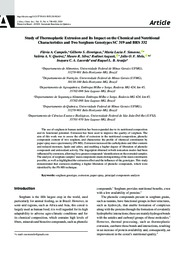Study of thermoplastic extrusion and its impact on the chemical and nutritional characteristics and two sorghum genotypes SC 319 and BRS 332.
Study of thermoplastic extrusion and its impact on the chemical and nutritional characteristics and two sorghum genotypes SC 319 and BRS 332.
Author(s): CAMPELO, F. A.; HENRIQUES, G. S.; SIMEONE, M. L. F.; QUEIROZ, V. A. V.; SILVA, M. R.; AUGUSTI, R.; MELO, J. O. F.; LACERDA, I. C. A.; ARAÚJO, R. L. B.
Summary: The use of sorghum in human nutrition has been expanded due to its nutritional composition and its functional potential. Extrusion has been used to improve the quality of sorghum. The aim of this work was to assess the effect of extrusion in the nutritional composition, phenolic compounds content of two sorghum, and characterize the profile of chemical constituents by paper spray mass spectrometry (PS-MS). Extrusion increased the carbohydrate and fiber contents and reduced moisture, lipids and ashes, and enabling a higher degree of liberation of phenolic compounds and antioxidant activity. The fingerprint obtained in both ionization modes had been influenced by extrusion, allowing for a greater compounds? identification on the extruded samples. The analysis of sorghum samples? main components made distinguishing of the main constituents possible, as well as highlighted the extrusion effect and the influence of the genotypes. This study demonstrated that extrusion enabling a higher liberation of phenolic compounds, which were identified by the PS-MS technique.
Publication year: 2020
Types of publication: Journal article
Unit: Embrapa Maize & Sorghum
Observation
Some of Embrapa's publications are published as ePub files. To read them, use or download one of the following free software options to your computer or mobile device. Android: Google Play Books; IOS: iBooks; Windows and Linux: Calibre.
Access other publications
Access the Agricultural Research Database (BDPA) to consult Embrapa's full library collection and records.
Visit Embrapa Bookstore to purchase books and other publications sold by Embrapa.

